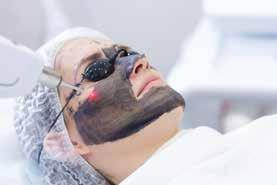
CO2 carbon laser treatment, also known as fractional CO2 laser resurfacing, is an advanced cosmetic procedure used to improve the appearance of the skin by targeting various skin concerns, including wrinkles, fine lines, scars, uneven skin tone, and texture irregularities. Here’s how CO2 carbon laser treatment works and what it entails:
Laser Technology
CO2 carbon laser treatment utilizes a high-energy laser beam emitted in a specific wavelength of light (usually in the infrared spectrum) to target and heat up the water molecules in the skin’s tissues. This causes controlled thermal damage to the skin, triggering a natura
Skin Resurfacing
The controlled thermal damage induced by the CO2 carbon laser promotes skin resurfacing and regeneration. As the skin heals, old, damaged skin cells are sloughed off, revealing smoother, healthier, and more youthful-looking skin underneath
Treatment Areas
CO2 carbon laser treatment can be used to address a variety of skin concerns on the face, neck, chest, and other areas of the body. It is commonly used to treat wrinkles, fine lines, acne scars, sun damage, age spots, uneven skin tone, and texture irregularities.
Fractional Approach
CO2 carbon laser treatment typically employs a fractional approach, meaning that only a fraction of the skin’s surface is treated during each session. The laser creates microscopic columns of thermal injury, leaving surrounding areas of skin intact. This allows for faster healing and reduces the risk of complications compared to traditional full-field laser resurfacing.
Collagen Stimulation
One of the key benefits of CO2 carbon laser treatment is its ability to stimulate collagen production in the deeper layers of the skin. Collagen is a protein that provides structure, firmness, and elasticity to the skin. By promoting collagen synthesis, CO2 carbon laser treatment helps to improve skin firmness, texture, and overall appearance.
Customizable Settings
CO2 carbon laser treatment can be customized to suit individual skin types, concerns, and treatment goals. The laser settings, including energy level, pulse duration, and density, can be adjusted to optimize results while minimizing the risk of side effects.
Downtime and Recovery
While CO2 carbon laser treatment is highly effective, it typically requires a period of downtime for the skin to heal. Patients may experience redness, swelling, and peeling in the days following treatment, which gradually improves over the course of several days to weeks.
Overall, CO2 carbon laser treatment is a powerful and versatile option for skin rejuvenation, offering significant improvements in skin texture, tone, and overall appearance. It’s essential to consult with a qualified dermatologist or cosmetic surgeon to determine if CO2 carbon laser treatment is the right option for you and to discuss your treatment goals and expectations.
